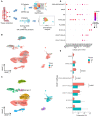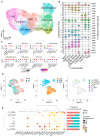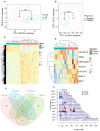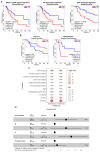Definition of a Multi-Omics Signature for Esophageal Adenocarcinoma Prognosis Prediction
- PMID: 39123475
- PMCID: PMC11311406
- DOI: 10.3390/cancers16152748
Definition of a Multi-Omics Signature for Esophageal Adenocarcinoma Prognosis Prediction
Abstract
Esophageal cancer is a highly lethal malignancy, representing 5% of all cancer-related deaths. The two main subtypes are esophageal squamous cell carcinoma (ESCC) and esophageal adenocarcinoma (EAC). While most research has focused on ESCC, few studies have analyzed EAC for transcriptional signatures linked to diagnosis or prognosis. In this study, we utilized single-cell RNA sequencing and bulk RNA sequencing to identify specific immune cell types that contribute to anti-tumor responses, as well as differentially expressed genes (DEGs). We have characterized transcriptional signatures, validated against a wide cohort of TCGA patients, that are capable of predicting clinical outcomes and the prognosis of EAC post-surgery with efficacy comparable to the currently accepted prognostic factors. In conclusion, our findings provide insights into the immune landscape and therapeutic targets of EAC, proposing novel immunological biomarkers for predicting prognosis, aiding in patient stratification for post-surgical outcomes, follow-up, and personalized adjuvant therapy decisions.
Keywords: RNA sequencing; cancer; esophageal adenocarcinoma; immune infiltrate; immunotherapy; response to therapy; single-cell RNA; single-cell sequencing; transcriptional signature; treatment.
Conflict of interest statement
The authors declare no conflicts of interest.
Figures




References
-
- Fassan M., Cavallin F., Guzzardo V., Kotsafti A., Scarpa M., Cagol M., Chiarion-Sileni V., Maria Saadeh L., Alfieri R., Castagliuolo I., et al. PD-L1 expression, CD8+ and CD4+ lymphocyte rate are predictive of pathological complete response after neoadjuvant chemoradiotherapy for squamous cell cancer of the thoracic esophagus. Cancer Med. 2019;8:6036–6048. doi: 10.1002/cam4.2359. - DOI - PMC - PubMed
LinkOut - more resources
Full Text Sources
Molecular Biology Databases

